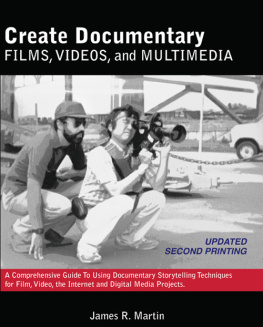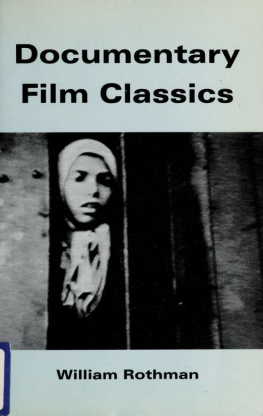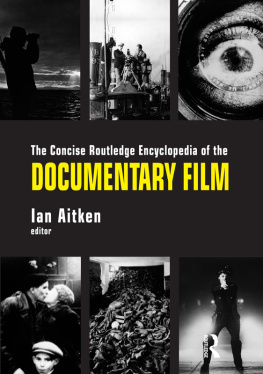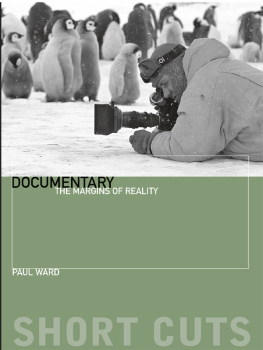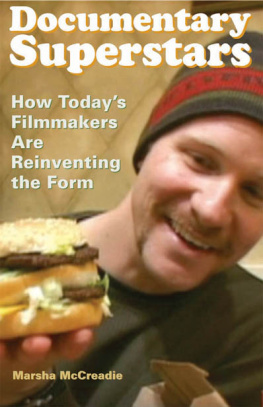How Documentaries Went Mainstream

Oxford University Press is a department of the University of Oxford. It furthers the Universitys objective of excellence in research, scholarship, and education by publishing worldwide. Oxford is a registered trade mark of Oxford University Press in the UK and certain other countries.
Published in the United States of America by Oxford University Press
198 Madison Avenue, New York, NY 10016, United States of America.
Oxford University Press 2023
All rights reserved. No part of this publication may be reproduced, stored in a retrieval system, or transmitted, in any form or by any means, without the prior permission in writing of Oxford University Press, or as expressly permitted by law, by license, or under terms agreed with the appropriate reproduction rights organization. Inquiries concerning reproduction outside the scope of the above should be sent to the Rights Department, Oxford University Press, at the address above.
You must not circulate this work in any other form and you must impose this same condition on any acquirer.
Library of Congress Cataloging-in-Publication Data
Names: Stone, Nora, author.
Title: How documentaries went mainstream: a history, 19602022 / by Nora Stone.
Description: New York, NY: Oxford University Press, [2023] |
Includes bibliographical references.
Identifiers: LCCN 2022060620 (print) | LCCN 2022060621 (ebook) |
ISBN 9780197557297 (hardback) | ISBN 9780197557303 (paperback) |
ISBN 9780197557327 (epub)
Subjects: LCSH: Documentary filmsUnited StatesHistory and criticism.
Classification: LCC PN1995.9.D6 S8275 2023 (print) |
LCC PN1995.9.D6 (ebook) | DDC 070.1/8dc23/eng/20230126
LC record available at https://lccn.loc.gov/2022060620
LC ebook record available at https://lccn.loc.gov/2022060621
DOI: 10.1093/oso/9780197557297.001.0001
For my parents
Contents
First, I must acknowledge my professors in the Department of Communication Arts at the University of WisconsinMadison. Their commitment to the highest ideals of scholarship has been a guiding light in my life. They taught me how to be a better scholar, writer, and teacher than I thought possible. Without the sterling education I received at Madison, this book would not have come to fruition.
Kelley Conway, Vance Kepley, and J. J. Murphy were particularly transformative mentors. Their gentle guidance and good humor kept me on track over the many years of this project, from seminar paper to dissertation to monograph. I aspire to their insight, tenacity, and impact on the field. When he was a new professor, Eric Hoyt advised graduate students to build something that other scholars could use. My hope is that this book fulfills that mandate.
As I followed my interest in documentary film and the mechanisms of distribution, I found likeminded folks: Tanya Goldman and Josh Glick. They are superlative colleagues and friends. A phone call with one of them always renews my excitement to research and theorize about documentaries.
Writing is a lonely sport. It is a comfort to look across a coffee shop table and see a friendly face, engaged in their own struggle with ideas and words. I treasure the time I spent crafting early versions of this manuscript alongside Maureen Rogers, Matt Connolly, and Caroline Leader.
My family has made the writing of this book possible. My parents, Steve and Julie Stone, are an unceasing source of strength and encouragement. Their emotional and material support made space for me to continue my scholarship. I am so grateful to them. Lily Stone and Will Chim kept my spirits up during the weeks and months of writing during the pandemic. Their admiration touches my heart. My in-laws, Bookie and Ray Ginter, Ryan and Bri Colvin, are an unexpected blessing. Their love and acceptance fortify me.
A profound thanks to my partner in all things, Brandon Colvin. He is my favorite person, and the person I admire most. His faith in me is a beacon. If I need help, he is there, helping me untangle problems and express myself more clearly. If I need motivation, he is there, reminding me of my passion for research and filmmaking. If I need comfort, he is there, delighting and embracing me every single day. This book, and my life, would be much poorer without him by my side.
investment in their production, documentary films are definitively more popular and prestigious than ever before.
Although the commercial ascension of documentary films might seem meteoric, it is the culmination of decades-long efforts on the part of innovative, intrepid filmmakers; risk-taking, often socially committed distribution companies; and institutions like public television stations, cable networks, film festivals, and contemporary streaming services that have developed and fortified the audience for documentary features. The commercialization of documentary filmmaking has transformed it into a media sector that promises sufficient financial stability and growth potential to attract sizable, consistent private investmenta remarkable inflection point in a history alternately defined by scrappy entrepreneurs and nonprofit advocates.
Three core tensions recur in this history. The first is documentary films dual foundation in the worlds of television and cinema. Television has been a persistent funding source and exhibition outlet for documentary films over the past sixty years, but this association has, at times, prevented documentaries from being seen as vital, engaging cinema. Releasing a film in theaters keeps it in the media cycle for a longer period than does a television broadcast, allowing it to accrue more reviews from critics, features from journalists, and word of mouth from audiences. Labeling a documentary a film also conveys a higher level of prestige and import. These differences in release structure and perception have contributed to documentary films commercial and discursive transition.
The second core tension is between the isolated entrepreneur and the organized institution. No matter the broader landscape for documentary, there are filmmakers who do whatever it takes to make documentaries and bring them to viewersthey fund production with personal favors and credit cards, self-distribute their work, form distribution collectives, publish films for free streaming over the internet. As documentary films commercial potential and connection with the commercial media industry have grown, so too have the number of commercial and nonprofit entities invested in them. It may appear that these institutions would eliminate the need for activist, entrepreneurial documentarians, but this development has in no way sidelined them. Instead, their persistent presence over time demonstrates that documentary retains a grassroots spirit and a connection to maverick American independent cinema.
Finally, and most crucially, there is the ambiguity surrounding what the market for documentary films even is or should be. This tension extends throughout the history of documentary film in the United States and strikes at the heart of the difficulty of tracing documentary films commercialization. For documentary films, there is more to the market than a rationalized system of commodity exchange. The feature documentary market has a parallel and symbiotic element to it: the concept of public service. Some agents of this market, like distributors, are explicitly interested in documentary features as commodities that can be exchanged for profit like fiction features. Other agents, like government agencies, public broadcasters, and nonprofit organizations, are more interested in producing and circulating documentary features as a form of public servicea way to promote alternative ideas and cultural forms. Documentary filmmakers come to the market with a mix of these goals and must navigate each stage of the documentary world with an eye toward often-contradictory principles and imperatives. The intertwining of commodity exchange and public service is especially tight once a film begins to circulate through various exhibition sites and windows; documentaries supported by grants or by public TV, for instance, increasingly circulate through commercial spaces like theaters and streaming services.


